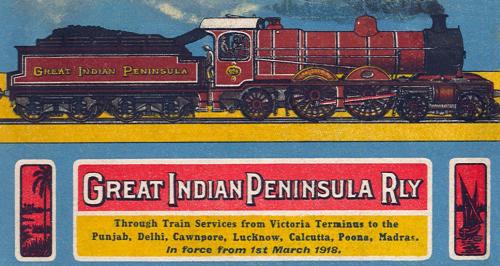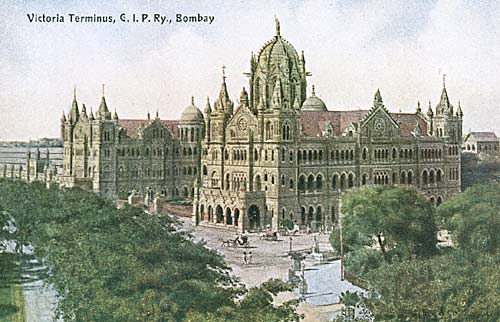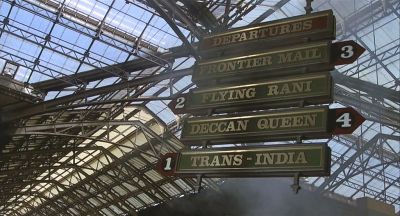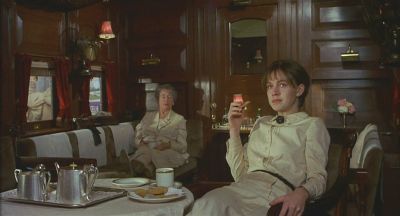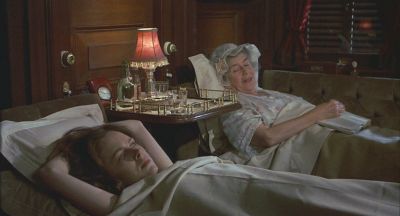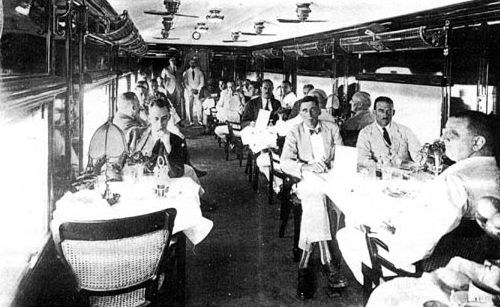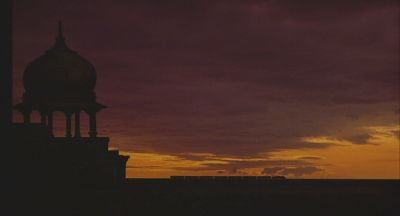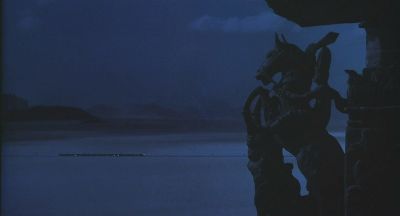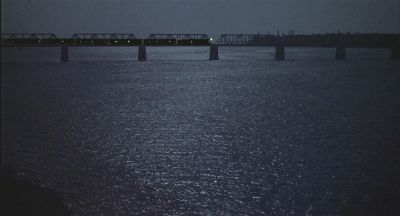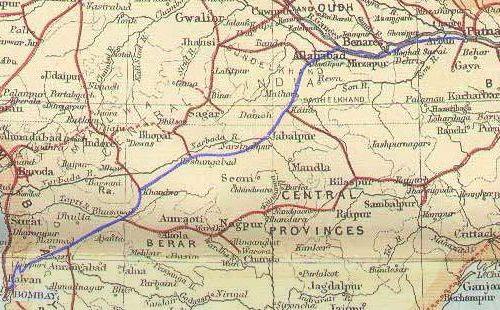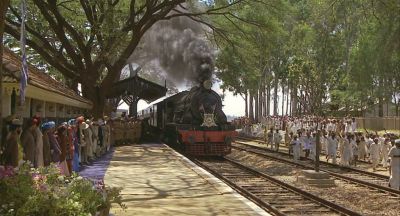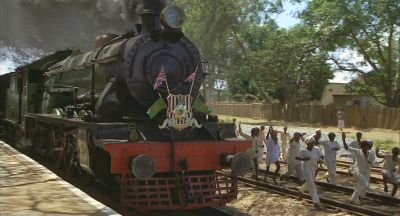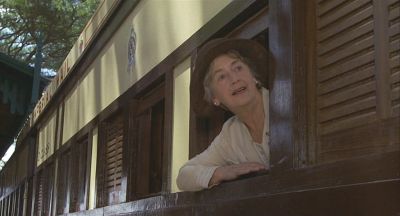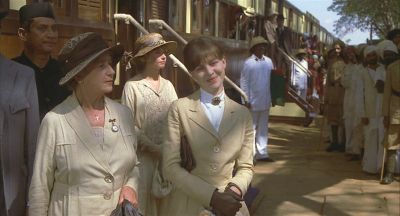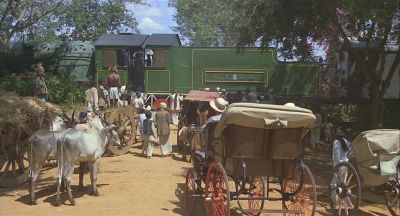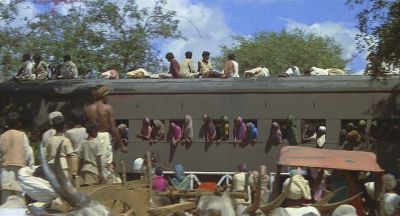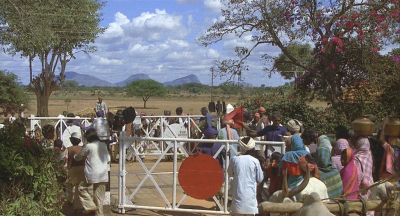Railway Scenes
In the era that the film depicts, railways were the quickest and most reliable way to cover the great distances that are India. Mrs Moore and Adela take a horse-drawn tonga from Ballard Pier to what is perhaps the most famous railway station in Asia: Victoria Terminus, now renamed Chhatrapati Sivaji Terminus.
David Lean did not use any images of the station itself in the film, limiting himself to the shot of the departure-boards, below. Many of these famous trains with such evocative names have now gone for ever, though the Flying Rani (Mumbai - Surat) and the Deccan Queen (Mumbai - Pune) are still available. The Frontier Mail, which took passengers for the north, was renamed The Golden Temple Mail. The 'Imperial Mail' that Mrs Moore and Adela travel on to get to Chandrapore is perhaps the 'Imperial Indian Mail', a prestigious train of the time that ran between Bombay and Calcutta. Introduced by the East Indian Railway and the Great Indian Peninsular Railway in 1926, the train's schedule was such that the departures from Bombay made for convenient connections for passengers arriving by ship from England. The train was known for a high level of luxurious accommodation. It carried only 32 passengers, and their staff. This train was the forerunner of the Calcutta Mail trains of later years. Listen to Mark Tully's fascinating documentaries about this train in 2003: Programme One (30 mins) and Programme Two (30 mins). You can see more photos of the Great Indian Peninsular Railway at David Flitcroft's photo-page here, or at the Science & Society Picture Library here.
What is the exact date that the film was set in? Most people would say the late 1920's. I had hoped to get some idea from the sign-boards, but after researching the topic at the IRFCA FAQ site, it became obvious that such a notice board never existed at Victoria Terminus. The Frontier Mail first ran on Sept 1st 1928. The Flying Rani didn't run after April 24th 1914 - it ran again as The Flying Queen on May 1st 1937, though at the inauguration ceremony the train was also referred to as the 'Flying Ranee, Queen of the West Coast'. The Deccan Queen first ran on June 1st 1930. The dates just don't add up, unless the film is set after May 1st 1937. Another problem arises, too. The Flying Rani ran from Bombay's Central station, not Victoria Terminus. As mentioned on the London page, the 'Rawalpindi' steamship had a short life of just 14 years, between 1925 and 1939. If we accept that the reference to the Flying Rani on the Victoria Terminus noticeboard was a mistake, the date for the film can only have been between 1930 and 1939.
Hmmm, that's strange - why does the word 'Delhi' appear outside the carriage window ? (Spotted by Mohan Bhuyan)
Were these carriage-interiors real, or were they made specially for the film? I suspect the latter. There are a number of rail museums in India: the National Rail Museum at New Delhi, and others at Mysore, Nagpur, and Chennai, but I have not been able to find where the carriages were then, or are now. Carriages are also located at other sites, such as the State Railway Carriage at the Lalgarh Palace Hotel, Bikaner, Rajasthan; or the Royal Rail Saloon at the Riverside Palace Hotel, Gondal, Gujarat. There is even a privately owned one, once belonging to the Maharajah of Jodhpur, now in the collection of Mr Thakral, general manager of the Le Meridien Hotel in Delhi.
This image shows a scan of the Dining Saloon on the 'Imperial Indian Mail', East Indian Railway, dated 1929. Scan provided by John Lacey.
Which bridge and river is this? Perhaps it was meant to be the Narmada near Jabalpur, the Ganges at Allahabad, or the Ghaghara at Chapra.
The locomotive used in this shot is an 'XC' class 4-6-2, heavy-passenger, broad gauge, with an axle-load of 19.5 tons. When not in use for filming, it was stabled at Bangalore Cant station. The location for 'Chandrapore station' is Dodballapur, aka Doddaballapura, a small town about 23 miles north of Bangalore, on the main line via Dharmavaram Junction to Bombay. Thanks to Anu and Saifullah for identifying it. See photos of how the station looked in 2004 on the IRFCA picture gallery here and here and here. See a map of Bangalore and Dodballapur on my Marabar Caves 1 page. See photos of Dodballapur Station from my 2017 visit on the Dodballapur page, and more notes on Dodballapur in the film on the Dodballapur 2 page.
More photos of historical steam locomotives can be seen at the IRFCA Gallery.
This is an interesting shot, showing the steps that were brought to the doorways of the carriages to let the passengers disembark, in the same way that steps are brought to aircraft today. Since the film was made, the level of the platform at Dodballapur has been raised some 30" to make it easier to board the carriages.
Later on in the film, the railway re-appears in the film. Ronny Heaslop has collected Mrs Moore and Adela Quested from their visit to Mr Fielding's house, and is driving them back to his house. Their carriage is stopped at a level-crossing whilst a train passes. This is the same 'XC' engine that was used earlier at Chandrapore.
This time, the carriages have been replaced with modern Indian Railways carriages, painted a darker color, some of which has come off. The brackets above the windows are normally used to hold destination-boards. Travelling on the roof still happens today on parts of the Indian Railways network, but it is much rarer these days, especially on sections with overhead electric cables!
The coaches used in these scenes were old stock AC First coaches
Can anyone tell me where this level crossing is? Judging by the hills in the distance, which are probably the hills of Savandurga, I would guess that it is somewhere on this map, (taken from the OpenRailwayMap). Orange lines are railways, blue labels are stations.
The railway scenes now move from broad gauge to metre gauge as the ill-fated expedition departs for the Marabar caves. The metre gauge rail-scenes were filmed on the Nilgiri Mountain Railway near Ooty. These are shown on a separate NMR page.

